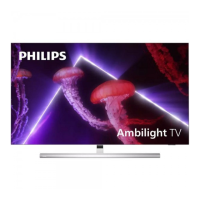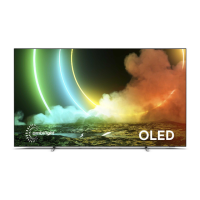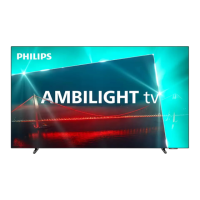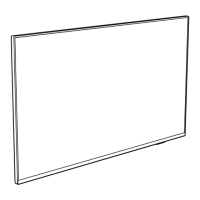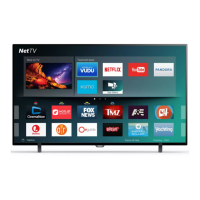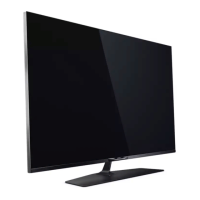Do you have a question about the Philips 55OLED806 and is the answer not in the manual?
Explains the Home screen layout, channels, and how to customize.
Emphasizes reading safety instructions before using the TV.
Instructions for installing the TV stand or mounting it on a wall.
How to connect and handle the TV's power cable.
Detailed description of each button on the remote control.
Steps to pair the Bluetooth remote control with the TV.
How to use voice commands for searching content on the TV.
How to turn the TV on, switch to standby, or use TV controls.
Steps for installing TV channels via antenna or cable.
How to tune to channels, switch between them, and use parental controls.
Details on automatic and manual channel updates.
How to perform a full TV reinstallation, resetting all settings.
Specific instructions for connecting HTS via HDMI ARC/eARC and audio sync.
Viewing photos, music, and videos from a USB flash drive.
Information on HDMI quality, cable length, and HDCP copy protection.
Connecting audio systems via HDMI ARC/eARC for audio return.
Instructions for connecting the TV to a home network via Wi-Fi or Ethernet.
Steps for establishing a wireless or wired network connection.
Instructions for connecting the TV to a network router using a cable.
Instructions to sign in to a Google Account for full Android TV features.
Explains where to find and install apps from Philips TV Collection or Google Play.
How to download and install new apps from the Google Play Store.
Checking TV storage usage and using USB drives for more storage.
Using Google Play Movies & TV and Google Play Games.
Setting parental controls and maturity levels in the Google Play Store.
Setting up a restricted profile to limit available apps.
Using a USB Hard Drive to extend TV memory for apps.
Locking apps based on age rating or setting up restricted profiles.
How to launch and use the TV's internet browser.
How to open the Quick Menu for fast access to TV functions.
Selecting different connected devices or tuners to view content.
Fine-tuning picture quality with noise reduction and MPEG artefact reduction.
Optimizing contrast with Light Boost and HDR settings.
Selecting preset picture styles for easy adjustment and customization.
Adjusting noise reduction levels for clearer video content.
Information on HDR format support and automatic switching.
Smoothing artefacts in digital video content for better picture quality.
Enhancing picture sharpness and detail using Ultra Resolution.
Adjusting the TV's HDR processing level for optimal contrast.
Adjusting key picture parameters: colour, contrast, sharpness, and brightness.
Adjusting advanced colour settings like tint, enhancement, and temperature.
Enhancing contrast for better picture quality.
Setting up and formatting a USB Hard Drive for recording.
Adjusting motion styles and clarity for smoother video playback.
Instructions to switch the Ambilight feature on or off.
Resetting TV settings to factory defaults and reinstalling software.
Protecting the OLED screen from image retention with specific settings.
How to open video folders, play videos, and use video options.
How to open music folders, play music, and use music options.
How to open photo folders, view photos, and use photo options.
Playing media files directly from a USB flash drive or hard drive.
Scheduling programme recordings via the TV Guide.
How to open, tune to programmes, and view programme details in the TV Guide.
Explains requirements and methods for recording TV programmes.
Scheduling future programme recordings using TV Guide data.
Steps to pause and resume a live TV broadcast.
Using the mobile app as a remote control and for media streaming.
Casting apps and content from mobile devices to the TV.
Instructions to switch the Ambilight feature on or off.
Steps to open, select, and rent movies from video stores.
Instructions for accessing and using the Netflix app.
Explains Alexa's voice control capabilities on the TV.
Steps to set up and use Alexa voice control on the TV.
How to update TV software via Internet or USB.
Downloading and installing software updates directly from the internet.
Details of all physical ports and wireless connections on the TV.
Troubleshooting common sound issues like no sound or poor quality.
Recommendations for maintaining OLED screen health and preventing image retention.
Troubleshooting common picture issues like no picture or distorted images.
Explains the screen refreshing process for OLED TVs.
Troubleshooting common HDMI and USB connection problems.
Troubleshooting common network issues like Wi-Fi or internet connectivity.
Guidance on common issues like TV not switching on or remote control problems.
Specific advice for caring for OLED displays, including image retention.
Contacting Philips for TV support, service, or repairs.
Troubleshooting common Bluetooth pairing and connection issues.
General safety instructions for using the TV, including electrical hazards.
Precautions to prevent electric shock or fire hazards related to the TV.
Guidelines for cleaning and protecting the TV screen.
Safety guidelines for lifting, mounting, and handling the TV.
Precautions to prevent the TV from falling and causing injury.
Explains the Home screen layout, channels, and how to customize.
Emphasizes reading safety instructions before using the TV.
Instructions for installing the TV stand or mounting it on a wall.
How to connect and handle the TV's power cable.
Detailed description of each button on the remote control.
Steps to pair the Bluetooth remote control with the TV.
How to use voice commands for searching content on the TV.
How to turn the TV on, switch to standby, or use TV controls.
Steps for installing TV channels via antenna or cable.
How to tune to channels, switch between them, and use parental controls.
Details on automatic and manual channel updates.
How to perform a full TV reinstallation, resetting all settings.
Specific instructions for connecting HTS via HDMI ARC/eARC and audio sync.
Viewing photos, music, and videos from a USB flash drive.
Information on HDMI quality, cable length, and HDCP copy protection.
Connecting audio systems via HDMI ARC/eARC for audio return.
Instructions for connecting the TV to a home network via Wi-Fi or Ethernet.
Steps for establishing a wireless or wired network connection.
Instructions for connecting the TV to a network router using a cable.
Instructions to sign in to a Google Account for full Android TV features.
Explains where to find and install apps from Philips TV Collection or Google Play.
How to download and install new apps from the Google Play Store.
Checking TV storage usage and using USB drives for more storage.
Using Google Play Movies & TV and Google Play Games.
Setting parental controls and maturity levels in the Google Play Store.
Setting up a restricted profile to limit available apps.
Using a USB Hard Drive to extend TV memory for apps.
Locking apps based on age rating or setting up restricted profiles.
How to launch and use the TV's internet browser.
How to open the Quick Menu for fast access to TV functions.
Selecting different connected devices or tuners to view content.
Fine-tuning picture quality with noise reduction and MPEG artefact reduction.
Optimizing contrast with Light Boost and HDR settings.
Selecting preset picture styles for easy adjustment and customization.
Adjusting noise reduction levels for clearer video content.
Information on HDR format support and automatic switching.
Smoothing artefacts in digital video content for better picture quality.
Enhancing picture sharpness and detail using Ultra Resolution.
Adjusting the TV's HDR processing level for optimal contrast.
Adjusting key picture parameters: colour, contrast, sharpness, and brightness.
Adjusting advanced colour settings like tint, enhancement, and temperature.
Enhancing contrast for better picture quality.
Setting up and formatting a USB Hard Drive for recording.
Adjusting motion styles and clarity for smoother video playback.
Instructions to switch the Ambilight feature on or off.
Resetting TV settings to factory defaults and reinstalling software.
Protecting the OLED screen from image retention with specific settings.
How to open video folders, play videos, and use video options.
How to open music folders, play music, and use music options.
How to open photo folders, view photos, and use photo options.
Playing media files directly from a USB flash drive or hard drive.
Scheduling programme recordings via the TV Guide.
How to open, tune to programmes, and view programme details in the TV Guide.
Explains requirements and methods for recording TV programmes.
Scheduling future programme recordings using TV Guide data.
Steps to pause and resume a live TV broadcast.
Using the mobile app as a remote control and for media streaming.
Casting apps and content from mobile devices to the TV.
Instructions to switch the Ambilight feature on or off.
Steps to open, select, and rent movies from video stores.
Instructions for accessing and using the Netflix app.
Explains Alexa's voice control capabilities on the TV.
Steps to set up and use Alexa voice control on the TV.
How to update TV software via Internet or USB.
Downloading and installing software updates directly from the internet.
Details of all physical ports and wireless connections on the TV.
Troubleshooting common sound issues like no sound or poor quality.
Recommendations for maintaining OLED screen health and preventing image retention.
Troubleshooting common picture issues like no picture or distorted images.
Explains the screen refreshing process for OLED TVs.
Troubleshooting common HDMI and USB connection problems.
Troubleshooting common network issues like Wi-Fi or internet connectivity.
Guidance on common issues like TV not switching on or remote control problems.
Specific advice for caring for OLED displays, including image retention.
Contacting Philips for TV support, service, or repairs.
Troubleshooting common Bluetooth pairing and connection issues.
General safety instructions for using the TV, including electrical hazards.
Precautions to prevent electric shock or fire hazards related to the TV.
Guidelines for cleaning and protecting the TV screen.
Safety guidelines for lifting, mounting, and handling the TV.
Precautions to prevent the TV from falling and causing injury.
| Package depth | 160 mm |
|---|---|
| Package width | 1400 mm |
| Package height | 860 mm |
| Package weight | 27800 g |
| AC input voltage | 220-240 V |
| AC input frequency | 50 - 60 Hz |
| Energy efficiency scale | A to G |
| Power consumption (standby) | 0.3 W |
| Power consumption (typical) | - W |
| Screen shape | Flat |
| Response time | - ms |
| Display diagonal | 55 \ |
| Display brightness | - cd/m² |
| Display technology | OLED |
| Native aspect ratio | 16:9 |
| Contrast ratio (typical) | - |
| Display diagonal (metric) | 139 cm |
| Game mode | Yes |
| Processor cores | 4 |
| Teletext standards | Hyper-text |
| Audio formats supported | AAC, MP3, WAV, WMA, WMA-PRO |
| Image formats supported | BMP, GIF, JPEG, PNG |
| Video formats supported | AVI, MKV |
| Video compression formats | AVC, H.264, H.265, HEVC, MPEG1, MPEG2, MPEG4, VC-1, WMV9 |
| Subtitle formats supported | ASS, SMI, SRT, SUB, TXT |
| High Dynamic Range (HDR) technology | Dolby Vision, High Dynamic Range 10 (HDR10), High Dynamic Range 10+ (HDR10 Plus), Hybrid Log-Gamma (HLG) |
| Cables included | AC |
| Product color | Gray |
| Mercury content | 0 mg |
| Heavy metals free | Hg (mercury) |
| Panel mounting interface | 300 x 300 mm |
| Operating temperature (T-T) | 5 - 35 °C |
| Wi-Fi standards | Wi-Fi 5 (802.11ac) |
| Bluetooth version | 5.0 |
| Audio decoders | Dolby Atmos, DTS-HD |
| RMS rated power | 50 W |
| Number of speakers | 2 |
| Firmware upgradeable via | Auto upgrade wizard, Network, USB |
| Music apps | Spotify |
| Video apps | Amazon Prime Video, BBC iPlayer, Disney+, Netflix, YouTube |
| Operating system version | 10 |
| Operating system installed | Android |
| PC in (D-Sub) | No |
| Headphone outputs | 1 |
| USB 2.0 ports quantity | 3 |
| Consumer Electronics Control (CEC) | EasyLink |
| USB 3.2 Gen 1 (3.1 Gen 1) Type-A ports quantity | 0 |
| Tuner type | Analog & digital |
| Analog signal format system | PAL, SECAM |
| Digital signal format system | DVB-C, DVB-S, DVB-S2, DVB-T, DVB-T2, DVB-T2 HD |
| Stand depth | 280 mm |
|---|---|
| Stand width | 789 mm |
| Width (with stand) | 1227.8 mm |
| Height (with stand) | 719 mm |
| Weight (with stand) | 19400 g |
| Depth (without stand) | 68 mm |
| Height (without stand) | 705.6 mm |
| Weight (without stand) | 19000 g |
